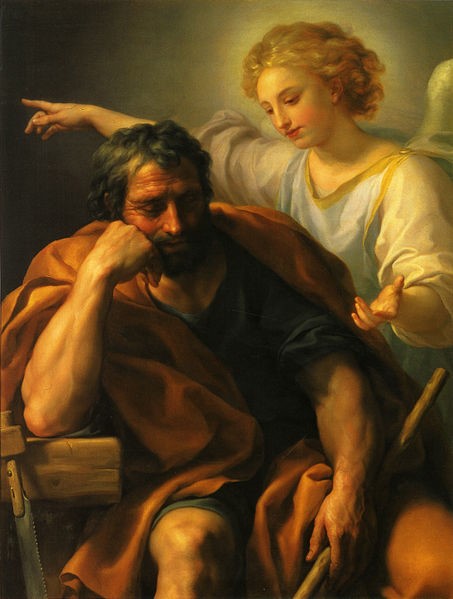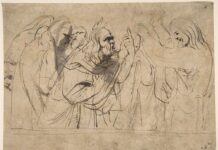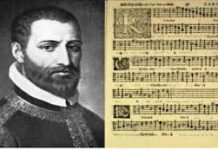(In Advent, our devotion is focused on Saint John the Baptist, as the precursor of the Christ, but then we shift in the latter days to the Holy Family – Our Lady, Saint Joseph, and the soon-to-be born Christ child. Here is a speculative reflection by Joshua Filipetto, on the confirmation of Saint Joseph in grace, as a fitting charism for his role as the Guardian of the Redeemer and Saviour of the World).
Quite some time ago I was watching a video by Christopher West, a renowned interpreter of Pope Saint John Paul II’s Theology of the Body. In his video titled “Hidden Mysteries of the Relationship of Joseph, Mary & Jesus,” West discusses some biblical typology between King David the Patriarch and Saint Joseph, and explains what this typology reveals about Saint Joseph’s relationship with Jesus and Mary. In summary, this is West’s observation and argument from the video: As King David distanced himself from the Ark of the Covenant, so also did Saint Joseph distance himself from the living Ark of the Covenant, viz., Mary, the Mother of God, and therefore in his relationship to Jesus and Mary as the only one who committed actual or personal sin in the Holy Family, Joseph is a model to all Catholics of what Jesus and Mary can do for us in our relationship with them.
What stood out most to me in this video was West’s thesis about the reality of Saint Joseph’s actual sin. West denies the Josephological doctrine taught by the Church of Saint Joseph’s Confirmation in the State of Grace three times in this video,[1] and these three denials are errors because this doctrine about Saint Joseph was officially taught by the Church, possessing the theological note or grade of certainty of a sententia bene fundata or “a well-founded belief.”[2] Ergo, a denial of this Josephological doctrine concerning Saint Joseph’s lifelong freedom from all actual sin — be it mortal sin or venial sin — would incur the theological censure of a propositio temeraria or a “temerarious proposition,”[3] and therefore — even though this doctrine does not possess the same level of binding force as a dogma of the Church does — the truth of Saint Joseph’s Confirmation in the State of Grace is binding for belief in the conscience of a Catholic as a matter of piety.[4]
Nevertheless, it is not my aim to generate a harsh critique of West; rather, I am merely endeavoring respectfully and charitably to point out an error in the science of Josephology concerning the sinlessness of Saint Joseph which West makes in this video of his and the gravity of said error. I am sure that West did not mean to mislead people, and that this was merely a Josephological error and a bad judgement. Furthermore, since I have pointed out elsewhere the reasons for the reality of Saint Joseph’s Confirmation in Grace,[5] and since such reasons can also be found in other sources on Josephology such as Joseph Most Just: Theological Questions about St. Joseph written by Father Francis Lad Filas, S.J., S.T.D.,[6] in this article I will offer a counter-argument to West’s argument which he presents in his video by using the very thing which West uses to argue for his thesis: biblical typology.
As said above, West says that Saint Joseph withdrew from Mary and did not take her into his home[7] on account of Saint Joseph’s supposed recognition of the guilt of actual sin on his soul, and West draws this conclusion from King David’s reaction to the Ark of the Covenant, who withdrew from the Ark and refused to take it into his city on account of his own sinfulness.[8] However, when one looks at the Old Testament and considers the ritual purity laws of ancient Israel, he sees that the biblical typology between the Aaronic priests and the Ark of the Covenant actually disputes West’s conclusion from his biblical typology and instead affirms the reality of Saint Joseph’s Confirmation in Grace. In the Book of Leviticus, God made it very clear to Moses that in order for a man to have served as an Aaronic priest in proximity to the Ark of the Covenant, he would have needed to be free from every imperfection — including moral imperfection, i.e., actual sin.[9] Since Saint Joseph is a priest according to the Order of Melchizedek,[10] and since what is true of the type — i.e., the prefigurement — must be true of the antitype — i.e., the thing prefigured — but in a greater way, therefore, if it was true that the Aaronic priests — who are the types of Saint Joseph — needed to be free from all actual sin in order to serve in close proximity to the Ark of the Covenant, then a fortiori it was also true that Saint Joseph — who is the antitype of the Aaronic priests — needed to be free from all actual sin in order to serve in close proximity to the living Ark of the Covenant, viz., Mary, the sinless Immaculate Conception herself. Hence, it seems that West cannot conclude from his biblical typology that Saint Joseph committed actual sin in his earthly life.
However, this entire discussion of finding a basis in biblical typology either for the reality of Saint Joseph’s actual sin or for the reality of Saint Joseph’s Confirmation in Grace is in vain for the following reason: Saint Thomas Aquinas, echoing the teaching of the Doctor and Father of the Church Saint Augustine of Hippo, is very clear in his Summa Theologiae that theological arguments can only be made from the Literal Sense of Scripture, and not from the Allegorical Sense of Scripture,[11] the latter being one of the Spiritual Senses of Scripture whose function is to indicate biblical typology.[12] The reason for this is stated well in the following medieval couplet: “The Letter speaks of deeds; Allegory to faith; The Moral how to act; Anagogy our destiny.”[13] Since it is the function of the Literal Sense of Scripture alone to state what “deeds” were done in Sacred Scripture or to narrate what actually happened in the Holy Bible, this means that the evidence for what actually happened in the Bible is found in the Literal Sense of Scripture, whereas the function of the Allegorical Sense of Scripture is not to narrate what actually happened in the Bible, but rather to indicate the content of the Catholic Faith. Hence, the foregoing is why Thomas gives another name for the Literal Sense of Scripture, viz., the Historical Sense[14]; for the Historical Sense of Scripture narrates true history, i.e., it tells us what actually happened in the Bible as the Literal Sense does, and — once again — the Allegorical Sense of Scripture cannot narrate true history or state what actually happened in the Bible because that is not its function.
Based on the foregoing, it stands to reason that one cannot use biblical typology either to theologically argue that Saint Joseph committed actual or personal sin during his lifetime — as West does in the video discussed in this article — or to argue that Saint Joseph was confirmed in grace for the entirety of his life, as I argue in this article. Therefore, the only way to theologically and biblically argue for Saint Joseph’s freedom from all actual and personal sin is to not merely look at how types in the Old Testament prefigure antitypes in the New Testament, but rather to look for the gesta or “deeds” of Saint Joseph in the New Testament. In other words, the only way to substantiate the reality and truth of Saint Joseph’s Confirmation in the State of Grace is to not look for this reality about Saint Joseph in the Allegorical Sense of Scripture by utilizing biblical typology, but rather to look for this Josephological doctrine in the Literal or Historical Sense of Scripture by utilizing biblical exegesis and biblical hermeneutics on the literal signification or meaning of the words of the Gospels.
To conclude this article, if one could find biblical evidence in the Literal or Historical Sense of the Sacra Pagina for Saint Joseph’s Confirmation in Grace, then this biblical evidence would be sufficient basis or foundation for this Josephological doctrine to be defined dogmatically,[16] and hence no one would commit the same error of denying the truth of Saint Joseph’s Confirmation in Grace as West does. In this scenario, this Josephological doctrine would no longer be a sententia in the realm of Theological Opinion as it currently is, but would rather be in the realm of dogma, and hence would possess a higher degree of binding force than its current degree, viz., a sententia bene fundata.[17] In fact, Saint Joseph’s Confirmation in Grace in this case would possess the highest degree of binding force, since it would be binding under pain of heresy and mortal sin to believe in Saint Joseph’s Confirmation in the State of Grace, as is the case for any dogma of the Catholic Faith.[18] In this scenario, all Catholics would come to love the Just Man of Nazareth for his freedom from all actual or personal sin, and would come to see Jesus, Mary, and Joseph together as models for holiness and moral perfection through their lifelong freedom from actual or personal sin, seeking the aid of all three members of the Holy Family to help themselves to become holy like them, rather than allowing Jesus and Mary to love Catholics “warts and all”[19] as West claims Jesus and Mary loved the “sinful Joseph.”
[1] Christopher West, “Hidden Mysteries of the Relationship of Joseph, Mary & Jesus,” Theology of the Body Institute, December 31, 2016, https://www.youtube.com/watch?v=8Qdj6SIz3xc, 9:27-9:30, emphasis in bold is mine: “Joseph is a fallen man like anybody.”; Ibid., 12:11-12:23, emphasis in bold is mine: “Joseph’s salvation is in drawing close with his shame, with his sinfulness, to the Immaculate Conception and the Word made Flesh.”; Ibid., 29:13-29:24, emphasis in bold is mine: “You gotta kind of feel sorry for Joseph, right? [chuckles] He’s the only sinner in this family, right? That means whenever something went wrong in the Holy Family, it was always Joseph’s fault!”
[2] Joshua Francis Filipetto, “What We Should Believe About Saint Joseph,” Catholic Insight, September 15, 2022, https://catholicinsight.com/what-we-should-believe-about-saint-joseph/; Father Chad Ripperger and Ryan Grant, “The Theological Notes of the Church ~ Fr Ripperger w/ Ryan Grant,” Sensus Fidelium, February 4, 2021, https://www.youtube.com/watch?v=T4hIgDR29bg, 1:00:18-1:01:15.
[3] Dr. Ludwig Ott, Fundamentals of Catholic Dogma, ed. James Canon Bastible, D.D., trans. Patrick Lynch, Ph.D. (Charlotte: TAN Books, 1974), 10.
[4] Fr. Chad Ripperger, The Binding Force of Tradition (Sensus Traditionis Press, 2013), 39: “Other than the last degree of certainty [i.e., the opinio tolerata or the “tolerated opinion”], the remaining degrees [i.e., the sententia probabilis or the “probable belief,” the sententia probabilior or the “more probable belief,” the sententia bene fundata or the “well-founded belief,” and the sententia pia or the “pious belief”] should normally be treated with some degree of respect insofar as they come from our fathers in faith, i.e. as a matter of piety…Rejection of [the sententia probabilis, the sententia probabilior, the sententia bene fundata, and the sententia pia] would not be sinful, generally speaking, but could be if the person does so out of impiety or some other vice.”; Ibid., 44: “Again, unless there is a sufficient reason [to not believe the teachings of the Church which are proposed within the realm of theological opinion], we are bound to hold even those [ecclesiastical teachings] of lower theological notes [viz., the theological notes which are within the realm of theological opinion, more specifically the sententia bene fundata, the sententia probabilior, the sententia probabilis, and the sententia communis].”
[5] Joshua Francis Filipetto, “What We Should Believe About Saint Joseph,” Catholic Insight, September 15, 2022, https://catholicinsight.com/what-we-should-believe-about-saint-joseph/; Joshua Francis Filipetto, “Joseph, the Very Type of the ‘Just Man’,” Catholic Insight, December 4, 2021, https://catholicinsight.com/joseph-the-very-type-of-the-just-man/.
[6] Francis L. Filas, S.J., S.T.D., Joseph Most Just: Theological Questions about St. Joseph (Milwaukee: The Bruce Publishing Company, 1956), 64-70. This book can be downloaded, read, and saved as a free PDF from Google Books at the following link: https://books.google.ca/books/about/Joseph_Most_Just.html?id=RZeItgAACAAJ&redir_esc=y.
[7] Matthew 1:19 (Revised Standard Version Catholic Edition).
[8] 2 Samuel 6:1-11 (Revised Standard Version Catholic Edition).
[9] Leviticus 21:1-24 (Revised Standard Version Catholic Edition).
[10] Joshua Francis Filipetto, “Joseph, a Priest According to the Order of Melchizedek,” Catholic Insight, May 27, 2022, https://catholicinsight.com/joseph-a-priest-according-to-the-order-of-melchizedek/.
[11] Saint Thomas Aquinas, Summa Theologiae, trans. Fr. Laurence Shapcote, O.P., ed. John Mortensen and Enrique Alarcón (Lander: The Aquinas Institute for the Study of Sacred Doctrine, 2012), I, q. 1, a. 10, ad 1, https://aquinas.cc/la/en/~ST.I, emphasis in bold and in italics is mine: “Et ita etiam nulla confusio sequitur in sacra Scriptura, cum omnes sensus fundentur super unum, scilicet litteralem; ex quo solo potest trahi argumentum, non autem ex his quae secundum allegoriam dicuntur, ut dicit Augustinus in epistola contra Vincentium Donatistam. [Thus in Holy Writ no confusion results, for all the senses are founded on one—the literal—from which alone can any argument be drawn, and not from those intended in allegory, as Augustine says (Epis. 48).]”
[12] Ibid., co; Catechism of the Catholic Church, n. 115 and 117.
[13] 5 Augustinus de Dacia, Rotulus pugillaris, I: ed. A. Walz: Angelicum 6 (1929) 256, quoted in Catechism of the Catholic Church, n. 118, emphasis in italics is mine: “Littera gesta docet, quid credas allegoria, moralis quid agas, quo tendas anagogia.”
[14] Aquinas, Summa Theologiae, I, q. 1, a. 10, co, emphasis in bold is mine: “Illa ergo prima significatio, qua voces significant res, pertinet ad primum sensum, qui est sensus historicus vel litteralis. [Therefore that first signification whereby words signify things belongs to the first sense, the historical or literal.]”
[16] Ott, Fundamentals of Catholic Dogma, 4: “[A] Dogma must be immediately revealed by God either explicitly (explicite) or inclusively (implicite), and therefore be contained in the sources of Revelation (Holy Writ [i.e., the Holy Bible or Sacred Scripture] or [Apostolic] Tradition).” What Dr. Ludwig Ott is saying here is that one of the requirements necessary for a Catholic doctrine to become a dogma of the Church is for it to be present in Public — not private — Revelation somehow, and that it is sufficient to find a basis or foundation for a dogma in one of the sources of Public Revelation, viz., either the Bible/Scripture or Apostolic Tradition.
[17] Ott, Fundamentals of Catholic Dogma, 9-10.
[18] Ibid., 5; Code of Canon Law, cann. 750 §1-§2, 751, 1364 §1.
[19] Christopher West, “Hidden Mysteries of the Relationship of Joseph, Mary & Jesus,” Theology of the Body Institute, December 31, 2016, https://www.youtube.com/watch?v=8Qdj6SIz3xc, 28:05-28:09.











